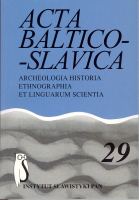Określenia mrozu i powierzchni pokrytych lodem w białoruskich gwarach na Grodzieńszczyźnie
Definitions of "the frost and ice-covered surfaces" in Belarusian dialects of the Grodno Oblast
Author(s): Bogumił OstrowskiSubject(s): Language and Literature Studies
Published by: Instytut Slawistyki Polskiej Akademii Nauk
Keywords: etymology; the Belorussian language; meteorological names; dialects
Summary/Abstract: This publication finishes the series of articles on meteorological terminology in Belorussian dialects around Grodno. I decided to draw a comparative method taking into consideration both structural and semantic aspects. This let me systematize and, in some examples, compare terms of wide comprehension, the extent of lexemes, and also, ascertain their origin provenience which led to recognizing and merging them into a certain chronological part of vocabulary. Thinking about the oldest one, it is possible to relate the words that have a wide, all – Slav extent of using. They are believed to create the common heritage of proto-Slavonic (or even proto-Indo-European) epoch thanks to the words such as: мароз ‘frost’, лёд ‘ice’, галалёд, галялёдзіца, ‘glaze’ and груда ‘frozen ground’, and probably шарэш ‘glazed frost’(*сереж < p-Sl.*ser-g-). It is important to say that these words describe the most elementary ideas and notions. In this group of words there is one specific example with East-Slavonic extent while its Belorussian continuant (feminine галашчáка : галашчóка < *gološčekъ) is just used in the area of Grodno. The other group is created by the words with the proto-Slavonic origin of stem, however, they came into being after the collapse of language community based on the characteristic word – formation in the certain language area. They could also appear owing to some appropriate specific phonetic transformations. In this group there can be put some local derivates such as: маразіско, маразянка (in relation to commonly used мароз), зімнік, падзімак, прызімак, ‘frost’ (based on proto-Slavonic stem *zim-), галялёдзіха ‘glaze’ (with suf. -іха contrary to галялёд, галялёдзіца in literary style), аблівака ‘glaze’, and probably рáна, (<*хрáна) ‘frozen ground’. Additionally, to this group belong the words which admittedly have the same structural synonyms in cognate Slavonic languages or their dialects, but with the new semasiology. The clear example of this fact is the word шрóні, originated from Grodno with the meaning: ‘the pieces of ice’. It illustrates the opposition to the former proto-Slavonic meaning ‘hoar – frost’: *sernъ / *sernь another example is прадýшына – ‘ice – hole’ (compared with a ‘hatch or chimney’ according to the literary style: ‘an opening in a ceiling, through which smoke or steam is carried away’). The other substantial example is дзíрны – ‘frozen mud’ (in the face of the fixed in all Slavonic languages – meaning ‘sod’ : *dŕnъ : *dŕno), or зыба f. ‘a thin layer of ice’ in contrary to p-Sl. *zybъ. ‘wave smoothly the sheet of water’. The third and the least numerous group consists of the words adopted from Polish language or is changed by the influence of Polish phonetic system, eg.: шрóні, слізгóта, and слізгавíца, ‘glaze’, сóплі, ‘icicles’, зéмбіць ‘frozen’ and also possibly трыскýць ‘frost’ and шарэш ‘glazed frost’.
Journal: Acta Baltico Slavica
- Issue Year: 2005
- Issue No: 29
- Page Range: 147-157
- Page Count: 11
- Language: Polish

